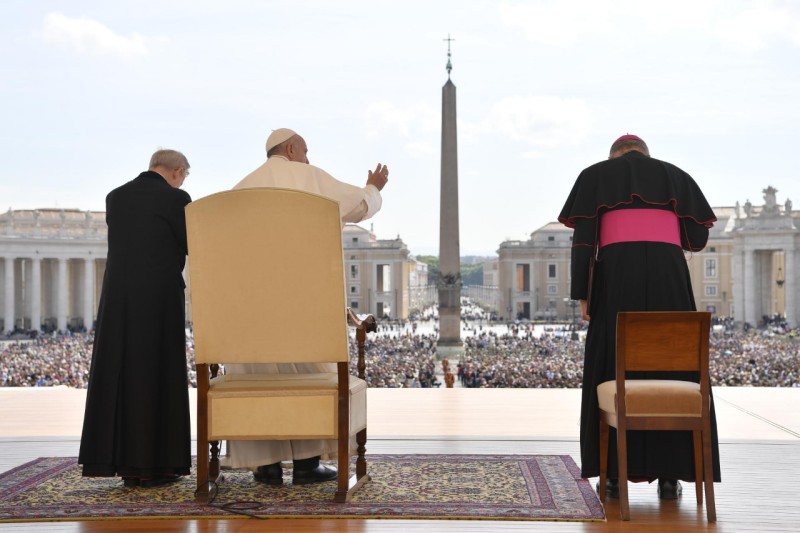“Our Lady of the Rosary, help us to be one body and one soul, a holy people en route to our Heavenly homeland,” prayed Pope Francis in a Tweet published on May 8, 2019, on the occasion of the “Supplication” of Pompeii, held at the Pontifical Shrine of the Virgin of the Rosary.
During the General Audience, over which the Pope presided this morning, in St. Peter’s Square, he recalled this traditional prayer: “We are in spiritual union with all those in that Marian Shrine, as elsewhere, who will come together at midday to recite with faith the Supplication to Our Lady, so that She may turn her gaze on the world and intercede for the whole Church and for all those suffering in body and in spirit.”
Moreover, added the Holy Father, celebrated in my homeland today is Our Lady of Lujan. Let us all pray together for Argentina.”
The Shrine of the new city of Pompeii, located some 20 kilometers from Naples – and 250 kilometers south of Rome — in Campania, was founded by Blessed Bartolo Longo: one day, during a walk in the countryside, this lawyer heard a voice say to him: “If you propagate the Rosary, you will be saved.”
He decided to spread devotion to the Virgin, beginning by building a new church dedicated to Our Lady of the Rosary. In 1883, he composed the “Supplication to the Queen of the Rosary of Pompeii,’’ recited traditionally at midday in Italy on May 8 and on the first Sunday of October, the month of the Rosary.
Around this Shrine, today a center of international pilgrimage, Bartolo Longo founded numerous social works for society’s little ones, in particular, orphaned and abandoned children and adolescents. Pope Francis went there on March 21, 2015.
As to Our Lady of Lujan, She is the Holy Patroness of Argentina. The image of the Virgin of Lujan arrived from Sao Paulo, Brazil, in May of 1630. Antonio Farias Saa, a property owner living in Sumampa (Santiago del Estero), wished to build a Chapel to the Virgin Mary in that land. He asked a Brazilian friend to procure for him an image of the Virgin. His friend gave him a representation of the Immaculate Conception and a Virgin and Child.
The transport from Brazil to Argentina was organized, then a cart from Buenos Aires to Sumampa. However, after a stop for the night on the bank of the Lujan River, some 68 kilometers West of Buenos Aires, near the “Estancia Don Rosendo,” the cart carrying these two images of the Virgin became immobile. Nothing could be done.
The cart drivers had the idea to move one of the images, but couldn’t do so. They replaced it and removed the second, and the cart was unblocked. They saw in it a sign of Heaven: the Virgin did not want to leave.” The family of “Estancia Don Rosendo” was moved by their story and agreed to keep the Virgin’s effigy.
The rumor spread to Buenos Aires and crowds of pilgrims went on route to Lujan. Don Rosendo decided to build a chapel to shelter the miraculous Virgin. In fact, miracles resulted from pilgrims’ prayers. The place became a village and later a small city.
More than two centuries later, in 1886, Father Salvaire presented Pope Leo XIII a petition of the Episcopate and faithful of the River Plate, asking for the Crowning of the Virgin of Lujan. The Pope blessed the crown and accorded it an Office and a Mass.
Given the affluence of pilgrims, it was decided to build a National Basilica. The works lasted from 1889 to 1937, in keeping with the plans of French architect Ulderic Courtois. Today the Lujan Shrine is one of the most important in Latin America, with some six million annual pilgrims.

© Vatican Media
Our Lady of the Rosary of Pompeii: On Route to Heaven, the Pope’s Prayer
‘For All Those Suffering in Body and in Spirit’


